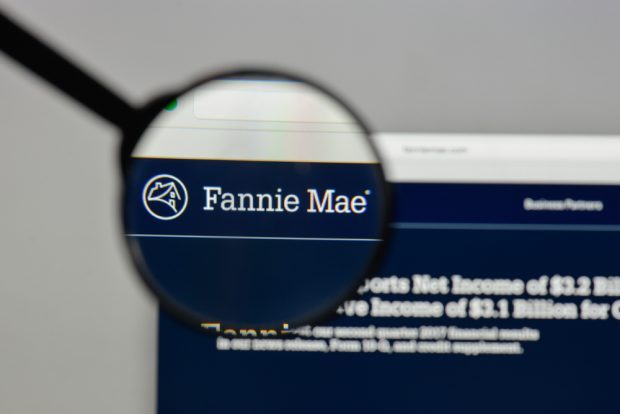 Source: Shutterstock.
Source: Shutterstock.
Fannie Mae and Freddie Mac's watchdog has a vision for ending U.S. control of the mortgage giants that hinges on the companies holding more capital. But that dream could run into a cold political reality of making home loans more expensive as President Donald Trump ramps up his re-election bid.
Federal Housing Finance Agency Director Mark Calabria, who became Fannie and Freddie's regulator in April, has said the companies need to raise capital buffers to protect against the kinds of catastrophic losses they had during the 2008 financial crisis. He doesn't want to release Fannie and Freddie unless they have sufficient backstops to prevent another taxpayer bailout.
Recommended For You
"It was insufficient capital that triggered the conservatorship, and it's going to be sufficient capital that triggers an exit," Calabria, a Trump appointee, said last month at a mortgage banking conference in New York. He added that he wants Fannie and Freddie ready to start raising funds by January.
To get there, Calabria has suggested the companies boost their capital levels to as much as 5% of assets, which would be a whopping $274 billion. For a cushion that high, mortgage finance experts say Fannie and Freddie would probably have to increase the fees they charge lenders to insure against borrower defaults. Those expenses would be passed along to home-buyers.
Economic Impact
A downside: mortgage costs could go up. Trump is heading into his re-election campaign with his approval stuck at less than 45% in almost every poll, and his chances for winning a second term may depend on the health of the economy next year. Any housing woes would add another potential impediment, along with his trade war with China and possible new tariffs on Mexico.
"It's unnecessary and doesn't make any sense," said Mark Zandi, chief economist of Moody's Analytics, who believes that fees Fannie and Freddie charge are already at appropriate levels. "Higher mortgage rates will raise payments and reduce demand. Less demand will mean lower house-price growth."
Figuring out a fix for Fannie and Freddie, something Trump has called a "pretty urgent" problem, is the main unresolved issue from the 2008 meltdown.
The Treasury Department is near completion of a plan to return Fannie and Freddie to private ownership that could be released within weeks, said people familiar with the matter. The White House is reviewing a draft of the proposal, one of the people said. Treasury Secretary Steven Mnuchin would have to sign-off on the plan before it's formally sent to the White House, and officials expect months to pass before any of it starts to be implemented.
An FHFA spokeswoman said the agency is still reviewing what would be sufficient capital levels for Fannie and Freddie. A Treasury spokesman didn't respond to a request for comment.
Taxpayer Rescue
Fannie and Freddie don't lend themselves. They buy mortgages made by lenders and wrap them into securities that are sold to investors with guarantees against default. The two companies were seized by regulators more than a decade ago and sustained by $191.5 billion in taxpayer money. They have since returned to profitability and sent more to the Treasury in dividends than they received in bailout funds.
Here's why capital impacts the fees that Fannie and Freddie charge lenders to backstop loans: The companies are expected by regulators and investors to earn money on their capital stockpiles. So if Fannie and Freddie have a combined $200 billion of capital and must make a 10% rate of return, then they would have to raise fees to a level that allows them to earn about $20 billion.
While under U.S. control, Fannie and Freddie are each restricted to a capital buffer of $3 billion, far less than they'd need to get through an economic downturn. Instead of retaining profits to build up capital, the companies send almost all of their earnings to the Treasury, a practice Calabria says he wants to bring to an end.
Fannie and Freddie's old capital requirements were suspended when they were seized by the government in 2008. New rules were proposed last year by then-FHFA director Mel Watt that would have had the two companies hold anywhere from $103.5 billion to $139.5 billion combined. Calabria is expected to issue a final plan later this year.
Like Insurers
Hedge fund manager Bill Ackman, whose firm is one of the largest holders of the companies' common stock, called the proposed higher capital levels unlikely and unnecessary on a recent earnings call.
"These are not banks," said Ackman, who runs Pershing Square Capital Management. "They're really insurance companies, and they're insuring what we believe to be one of the safest assets in the world, which is the first mortgage on, kind of, middle-class homes to a credit-worthy borrower on a geographically diversified basis."
Ackman said Fannie and Freddie will have all the capital they need at 2.5% of assets because of their "huge" cash flows.
Trump and Treasury officials have publicly said they want to work with lawmakers on an overhaul of housing-finance policy, though some within the administration are skeptical they can reach a compromise with House Democrats, said one of the people, who like others asked not to be named in discussing internal deliberations. That might prompt the administration to bypass Congress in releasing Fannie and Freddie.
© 2025 ALM Global, LLC, All Rights Reserved. Request academic re-use from www.copyright.com. All other uses, submit a request to [email protected]. For more information visit Asset & Logo Licensing.







